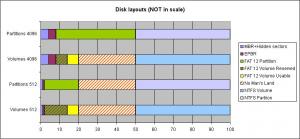Content Type
Profiles
Forums
Events
Everything posted by jaclaz
-
Good , then I would call it a day and call the 011 version "RTM" . What about the Readme.txt? Any ideas/suggestions for it? Find attached the tentative "release" version. jaclaz ReadMe.zip
-
Maybe it is due to the USB connected disk (or to some other disk connected with a "slowish" BUS/interface) , I am using a Virtual Disk, so it is probably as fast as the (SATA) drive on which the image is hosted. I can do nothing to speed up that, I believe. Try the attached (no version number change), at least it provides a more meaningful message. jaclaz Switcher011.zip
-

Forcing assign the selected letter to the system partition of Windows
jaclaz replied to egrabrych's topic in Windows XP
Sure XP is 2K (with mainly some bells and whistles added to it), but the method/approach is the same possibly since NT 3.5 and however hasn't changed in up to 8.x (and possibly even the stupid 10 won't be different). jaclaz -
Good. That is "queer". I have no such a pause on my machine. there is a slight, maybe 1/3 of a second delay before the "Please wait while DiskPart ..." line appears. How long does it take on your machine to start Diskpart from command line? And if you start it from command line, and you input the "rescan" command how long does it take for the "Please wait while DiskPart ..." line to appear? The attached .gif shows what happens here. jaclaz
-
Actually the "pause" should be after: not that much to be assumed . Try the attached 011 version , I "joined" a few lines of info and introduced some empty lines to (hopefully) better highlight what is being done. jaclaz EDIT: Removed, see a few posts below.
-
Would those references on Veign's site to WMI and having WMI Core in Win 98 be relevant? Or it has nothing to do with GDI? Would something like this: http://support.smartbear.com/viewarticle/54495/ work in 9x? jaclaz
-
It's only about your note about the cmd windows in some cases closing without giving the opportunity to review the full output, if we make the whole output, even in the "most complex" case, including the "removing of current letter assignment" fit into the "standard" 25 lines that issue is solved. What do you mean by "pauses", at least in Windows XP it seems to me like a "normal" speed, with a line of text output every fraction of a second, exception made for the Diskpart RESCAN, which is however "advertised" by the Diskpart output itself: I mean, if we take one of the last output you posted as a base and number the lines: As I see it, 1 and 2 can be removed without any particular problem, we could make 12 and 13 a single line and add an empty line after them and remove line 14, and we could as well make lines 20 and 21 a single line and remove line 26. The output would become: jaclaz
-

Forcing assign the selected letter to the system partition of Windows
jaclaz replied to egrabrych's topic in Windows XP
You need to edit a couple of values in the (offline) Registry. Letter assignment depends on the values inside the key: HKEY_LOCAL_MACHINE\SYSTEM\MountedDevices You need to edit \DosDevices\N: name, renaming it to \DosDevices\D: (if already a \DosDevices\D: value exists, you need to first rename this to a drive letter that doesn't exists, let's say \DosDevices\Z:) first. In UBCD there is PCregedit which should do nicely. jaclaz -

New XP install does not recognize new partition on HDD
jaclaz replied to oldtiger64's topic in nLite
@oldtiger64 #1 I mean, follow the "Option 2" in the given reference guide: http://www.sevenforums.com/tutorials/8057-dual-boot-installation-windows-7-xp.html when you get to Step 5, the guide shows this screenshot: Which I would describe as can you provide the description of what you see at that step? #2 good #3 good, the Windows 7 install uses a sort of "reduced" OS which is called Preinstallation Environment or PE for short, that would be (since it is Windows 7 based a PE 3.x), this may be useful for the install procedure. @cdob I believe that once the right driver (should the current one not be it) is found/integrated there will be anyway a couple of issues, the NTLDR/BOOT.INI/NTDTECT.COM will need to be installed to the "System" partition to fit into "early LBA", but I am not sure that the actual XP can be installed in a volume that resides entirely above the 48 bit LBA limit Do you recall similar setups? jaclaz -
Good. Let me know what do you think about making it less verbose. jaclaz
-
This also applies to the older version Usage Monitor. Since I am in an exceptionally good mood today , I will read the above as: jaclaz
-
So, 8 slots allow for 4 (or 5) programs? I guess that you should ask Mr. McAleavey for some clarifications/references to these 8 "slots". What you reported he told you here (set aside the "8 slots theory"): http://forums.superantispyware.com/index.php?/topic/499-can-i-run-more-than-2-real-time-antispyware-shield-incl-sas/?p=2275 makes a lot of sense : If I were you I would set aside this "8 slots theory" and run less programs in real time (making use - if you believe that your computer is not secure or not secure enough - some alternate means of protection, like - say - a hardware firewall and possibly an antivirus proxy). It is quite obvious that if you set several different programs, all aimed essentially to the same scope, to run at the same time doing essentially the same thing (accessing files to scan them either by checking their contents against a database of known signature or heuristically analyze them and/or monitoring them for changes) conflicts of some kind may well (please read as will) arise. On the other hand, Mr.McAleavey (do read the set of his articles listed here): http://www.wilderssecurity.com/threads/kevin-mcaleavey-writes-about-malware.304034/ has since concluded that there is no working/reliable solution if you run Windows and you would better forget about it and get his KNOS secure OS instead: http://www.knosproject.com/ jaclaz
-
It is surprising how common this opinion is among people who are professional software developers. Let's not forget how free can mean also freedom and not necessarily or only gratis. jaclaz
-
Good , and I am attaching it to this post, so that it doesn't get lost. jaclaz G.7z
-
Out of curiosity, WHO? Hmmm, something very UNlike a FCFS approach: http://en.wikipedia.org/wiki/First-come,_first-served which in computing would be correspondent to a FIFO one: http://en.wikipedia.org/wiki/FIFO_(computing_and_electronics) This approach is usually connected with "stacks" (and not with ""slots"), what you describe seems more like LABIFS (Last Arrived Bully Is First Served) WHAT is a "HIPS-type program"? Can you name EXACTLY all the programs you had running and which one failed? In other words, "somewhere on the internet". WHY? I mean, just for the fun of it, because someone told you that the more antivirus/antimlware programs you manage to run concurrently the more secure is your system, because otherwise your PC would run too fast, etc.? It would be IMHO advisable to first make sure that the 8 slots exist before increasing their number to 14. Told by WHOM? It is the first time I heard about this concept of "slots". Can't you remember any other detail about the source of these info? jaclaz
-
Good. While you are at it, check also this "Veign's Usage Monitor". Here is an old version: https://web.archive.org/web/20080316005020/http://www.veign.com/application.php?appid=110 Latest is possibly this one: https://web.archive.org/web/20140701191607/http://www.veign.com/application.php?appid=110 jaclaz
-
And most probably in early 2020 the Server 2008 R2 users will be forced to update to Server 2012! The: Windows Server 2008 (original release date 06/05/2008)Windows Server 2008 R2 (original release date 22/10/2009)Windows 7 (original release date 22/10/2009) all three have the same extended support ending on 14/01/2020, as it can be verified here: http://support.microsoft.com/lifecycle/search?sort=PNα= And on the 10/01/2023 users of Server 2012 will be needing to upgrade to the whatever will be released as "server" correspondent to Windows 10 ... ... the suspense is killing me.... jaclaz
-
... and, on the other hand, the actual user will not have the permissions/privileges (let alone the knowledge needed) to do anything similar, so they will be stuck to the senseless interface as MS provides it. ...BUT big OEM's (like -say - Lenovo or Samsung) will add to the system any kind of crapware in an attempt to mitigate the impact, with the net result that you will have several slightly different interfaces, some better and some worse, as it already happened with (respectively) Pokki and Quick Starter for Windows 8. jaclaz
-
Sure , that is actually the "original" way, exactly as posted by Sebijk https://www.sebijk.com/community/board9-community/board5-pc/2984-xp-updates-weiterbeziehen/ In the very early days of this thing, the entries for all the four "still supported products" were added, while soon after it was found out how only the PosReady was needed and enough. See also: http://www.msfn.org/board/topic/171814-posready-2009-updates-ported-to-windows-xp-sp3-enu/page-3#entry1078506 jaclaz
-
It's just a matter of adding (or editing) the entries in menu.lst according to what works in command line, like, as we saw on post #68: http://www.msfn.org/board/topic/156859-drive-order/?p=1041375 Probably you want to have: jaclaz
-

New XP install does not recognize new partition on HDD
jaclaz replied to oldtiger64's topic in nLite
Yep. , now it is much more clear. If you reduced the "thing" that you see as C: from the original 604 Gb to roughly 524 Gb in order to create the 80 Gb "thing" that you see as W:, then the "W: thing" begins past the 128 Gb mark in any case, no matter if the "C: thing" is actually at the beginning of the disk or not (usually it comes after the "system" partition, which should be normally 100 Mb in size). The issue is detailed here: http://support.microsoft.com/kb/303013/en-us It is possible - for any reason - that the EnableBigLBA setting is not in the Registry of the Setup CD you made nlite should have made that set properly, but you never know. But there is also another problem. The "system" partition (that MS insists on calling the other way round) is actually the "boot" partition, see: http://www.multibooters.co.uk/system.html Basically what you see as "system" and without a drive letter assigned is a primary partition with an ID of 0x27 (this is a "special" partition ID that makes Windows 7 NOT assign a drive letter to it), which is actually a NTFS formatted volume inside a partition that is marked as "Active" (and that would normally have a partition ID of 0x07). Windows XP knows nothing about a partition with ID 0x27, and this is very likely to create issues when installing, once the other issue has been solved. Bear with me, please. Right now your PC boot sequence is the following: BIOS->MBR->bootsector of the Active partition (the "no drive letter", "system" partition with ID 0x27)-> BOOTMGR ( residing also on the "no drive letter", "system" partition with ID 0x27)->choices in \boot\BCD( residing also on the "no drive letter", "system" partition with ID 0x27)-> WINLOAD.EXE (residing on the "C: thing")-> Windows 7 The normal booting sequence of XP is instead: BIOS->MBR->bootsector of the Active partition (which cannot be of type 0x27, and it is usually at the same time "system" and "boot" volume, and that in your case will probably correspond to the "W: thing" )->NTLDR (residing on the "W: thing")->choices in BOOT.INI (also residing on the "W: thing")->Windows XP kernel (also residing on the "W: thing"). In other words, even once we will manage to have the XP install "see" the "W: thing" you should NOT proceed to install. IF you do install in that situation AND the XP install gives no issues, you will lose the possibility of booting to the Windows 7 (and it might be tricky to fix the situation), while IF you do install in that situation BUT the XP install has any issue, you will have a completely NON bootable system, i.e. both XP and 7 will fail loading) All MS OS installs are "predatory" in the sense that they take over the boot sequence, altering it along the lines of what they think is "best". Of course when you install a later OS (let's say a Windows 7 after having installed the XP) the setup has an automatic option to "import" the existing previous OS booting, but obviously a previous OS knows nothing about a later one and simply writes the "own" boot sequence. A procedure is given here (option 2): http://www.sevenforums.com/tutorials/8057-dual-boot-installation-windows-7-xp.html BUT it is NOT advised (by me) to follow that method, as it gives you not any control on drive letter assignment (in the XP) and it is more generally "risky" and needing tools that I (personally) do not recommend. Still it is useful as a reference. Right now you did what is detailed on that guide under "option 2" up to point 5, I believe. Questions: 1) What do you see right now at that step? (I need to understand what is the situation now, before suggesting you how to go on). 2) Can you (if needed) re-create the .iso (with or without nlite)? 3) Do you have a PE of some kind (please describe) or the Windows 7 install DVD? jaclaz -
Good. I have no idea why this happens , though with the latest versions of Switcher this should be not much of an issue (once outside the testing phase), as the output/feedback of the batch, even in the case of a complete switch/unmount/remouint should fit in a single window (without scrolling), we could even shave off some (unneeded) output of the batch like this part: that all in all is just "cosmetic", and thus gaining 4 lines of text, and remove the "ECHO" about the actual dsfo command and it's output, regaining another two lines. Probably (but cannot swear by it) the scan happens on one of the two interfaces (but not on the other) because the Windows 8.x "senses" *something wrong* on the FAT12 partition/volume. When the interface is 512, the situation is AFAICU "fully kosher", in the sense that the volume and the partition sizes and position match (though there is an abnormal number of reserved sectors in the volume). When the interface is 4096 instead the volume is much smaller than the partition (though it has just one reserved sector, please read as "normal"), so it is IMHO more likely that the scan is triggered on the 4096 interface. See the attached image. Yep . jaclaz
-

P55 INF driver ver:9.1.1.1014 last real support for win2k Pro
jaclaz replied to mcollins's topic in Windows 2000/2003/NT4
Hmmm, as I see it, between US$ 0 and US$ 1.5 million there are quite a few shades of gray. I mean, if we are talking real money, with anything between US$ 20,000 and US$ 200,000 you can have *anything* among (just ideas): a custom developed chipset driver a custom developed motherboard (actually several hundreds of them) that program "fixed" to run in a more stable and less "picky" way Colinux http://www.colinux.org/developed to your exact requirements/needs But there are several companies around specialized in "replacement hardware for the industry" that sell "custom made" motherboards/systems that can run *any* OS, typically they cost twice or thrice a typical "commercial" desktop, but nothing that cannot be actually afforded. As an example (and NOT an endorsement/recommendation), this thingy here: http://www.nixsys.com/nx-l90.html with ALL options, fastish processor (Intel P4 3.06GHz 512 Cache - 533MHz FSB ), max possible RAM of 2 Gb, 2x320 Gb hard disks, Gigabit NIC, Geforce dual video card, and a Windows 2000 license totals less than US$ 1200. I believe that trains are not increasing their traveling speed at the same rate PC's increase their performance, so that if you managed to use that crazy piece of software on 2002 hardware for more than 10 years, such a motherboard can run it for the next ten. jaclaz -

Can't extract .exe file with Universal Extractor
jaclaz replied to Maleny's topic in Software Hangout
BIOS drivers? Can you post a link to the exact page where you got them and/or post the exact model for what they are meant? jaclaz



